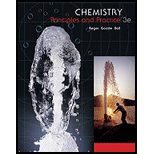
(a)
Interpretation:
The neutral atom that is isoelectronic with
Concept Introduction:
The group of atoms and ions that consists of the same number of electrons is known as isoelectronic series.
(a)
Answer to Problem 8.41QE
The neutral atom that is isoelectronic with
Explanation of Solution
The
The neutral atom that is isoelectronic with
(b)
Interpretation:
The neutral atom that is isoelectronic with
Concept Introduction:
Refer to part (a).
(b)
Answer to Problem 8.41QE
The neutral atom that is isoelectronic with
Explanation of Solution
The atomic number of
The neutral atom that is isoelectronic with
(c)
Interpretation:
The neutral atom that is isoelectronic with
Concept Introduction:
Refer to part (a).
(c)
Answer to Problem 8.41QE
The neutral atom that is isoelectronic with
Explanation of Solution
The atomic number of
The neutral atom that is isoelectronic with
(d)
Interpretation:
The neutral atom that is isoelectronic with
Concept Introduction:
Refer to part (a).
(d)
Answer to Problem 8.41QE
The neutral atom that is isoelectronic with
Explanation of Solution
The atomic number of
The neutral atom that is isoelectronic with
Want to see more full solutions like this?
Chapter 8 Solutions
Chemistry
- Which of the four atoms Na, P, Cl, or K (a) has the largest atomic radius? (b) has the highest ionization energy? (c) is the most electronegative?arrow_forward6. Which of the following species is not isoelectronic with sulfide? A. Ar B. Sc3+ C. Kr D. P3–arrow_forwardWhat is the relationship between the value for the first ionization energy of a Cl-1g2ion and the electron affinity of Cl1g2?arrow_forward
- A main group element with the valence electron configuration 4s24p4 is in periodic group ______ .It forms a monatomic ion with a charge of_________ .arrow_forwardgive the charge of the transition metal Ag2C2O4arrow_forwardFor each of the following pairs of atoms, state which youexpect to have the higher first ionization energy: (a) Bi orXe; (b) Se or Te; (c) Rb or Y; (d) K or Ne.arrow_forward
- Which of the following elements would be expected to have the highest first ionization energy (IE1)?arrow_forwardWhich element would you expect to have the highest second ionization energy (IE2)? Na, Mg, Alarrow_forwardWrite electron configurations for the following ions of d-block elements: (a) Zn2+, (b) Mn2+, and (c) Cr3+.arrow_forward
- What is the identity of the ion with an electron configuration [Xe]4f145d9 and has a charge of +4?arrow_forward7.55 Give three examples of first-row transition metal (Se to Cu) ions that are isoelectronic with argon.arrow_forwardWhich items from the following list are diamagnetic? Mg, Mo, Si , Hgarrow_forward
 Chemistry: Principles and PracticeChemistryISBN:9780534420123Author:Daniel L. Reger, Scott R. Goode, David W. Ball, Edward MercerPublisher:Cengage Learning
Chemistry: Principles and PracticeChemistryISBN:9780534420123Author:Daniel L. Reger, Scott R. Goode, David W. Ball, Edward MercerPublisher:Cengage Learning Chemistry: Principles and ReactionsChemistryISBN:9781305079373Author:William L. Masterton, Cecile N. HurleyPublisher:Cengage Learning
Chemistry: Principles and ReactionsChemistryISBN:9781305079373Author:William L. Masterton, Cecile N. HurleyPublisher:Cengage Learning

